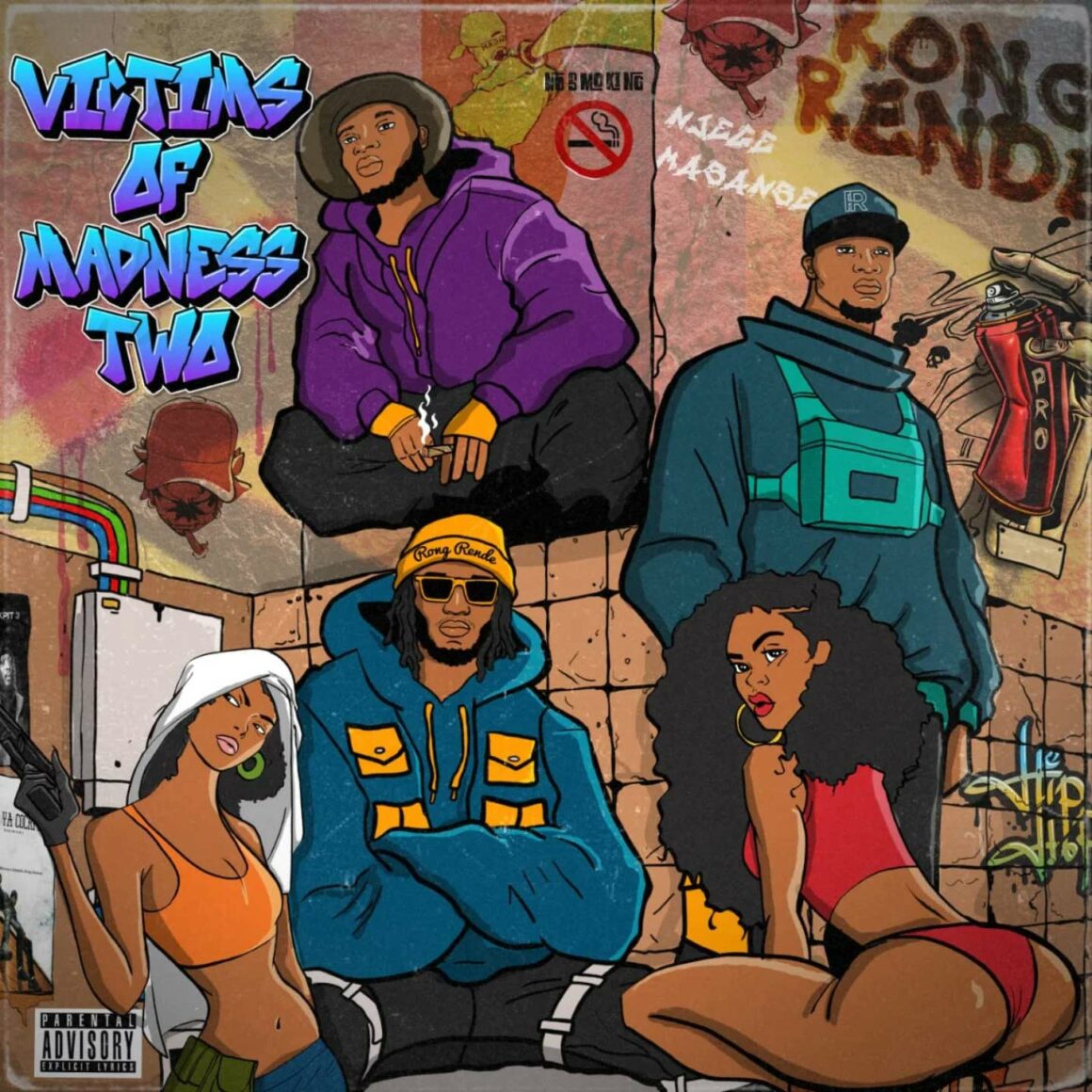Victims of Madness (2020) may not have been their first album, but for many, it was the first time Wakadinali truly hit home. After years of relentless grinding in Nairobi’s underground hip hop scene, Victims of Madness marked Wakadinali’s first major breakthrough. Five years on, with a bigger stage and a bolder vision, they return with Victims of Madness 2.0, a sequel to the critically acclaimed, fan-fueled classic that made them impossible to ignore.

If the first Victims of Madness was a culmination of the first phase of what I like to refer to as the Wakadinali Cinematic Universe (henceforth referred to as the WCU), then this album is the end point of phase two. The past five years have seen Wakadinali working harder than ever, with canon events such as the release of the third installment in their Ndani ya Cockpit album series while still getting some work in on solo projects such as Wada and Mauru Unit by Sewersydaa and Chonjo by Scar Mkadinali. They have also been busy being featured on various singles by several other artists. Over this period Wakadinali have also worked on bolstering the profiles of their affiliates, according to them high profile features on their songs and even releasing their music under the Wakadinali name on streaming services. Artists such as Skillo, Sudough Boss, Katapilla and Kitu Sewer have been significantly highlighted by this and at this point they feel like an extension of the Wakadinali group instead of just being affiliates.
In 2025, the greater Wakadinali Cinematic Universe is as deep and full of lore as any long running anime. They have fully established their own mythology, alter egos and language, remixed from Eastlands and other neighborhoods in Nairobi. The music is an endless pool of aliases , inside references between the group members, lyrics lined with mentions to whatever (anime) show Domani Munga is fixated on at the moment (Yujiro Hanma anyone?), street hustler ideologies, and ultra-specific Nairobi geography. With a rollout that has lasted over a whole year since the release of the lead single “Hizi Stance” and hit singles such as “Maproso” and “Tamashani”, it was a only a matter of time before the much anticipated album was released this year.
This sprawling, gloriously messy album takes no prisoners. Playing back for one hour and twenty three minutes, it has the run time of a Hollywood movie in the 2000s. The album is full of hard bars from every featured rapper, dense wordplay, and twisted humor that straddles the line between the reality of living in Nairobi and fantasies of being the top shottas on the block. The album’s production switches from unrelentingly dark to a tropical brightness that allows the album to have a sonic transition that is noticeably smooth despite the sharp tonal differences in the soundscapes.
On Victims of Madness 2.0, Wakadinali aren’t taking notes, they’re giving lessons. After five years of being at the top of the Kenyan music industry you can tell that they’re completely high on their own success. They made it to the mountain top and now everyone needs to be reminded that they’re still reigning on top, somewhere up there, a distance away from everyone. While the first Victims of Madness is a classic where the raw energy of the artists is palpable and the production sparks like a live wire, it also doesn’t feel like the most authentic Wakadinali experience. Munga, Scar and Sewersydaa are rule breakers, constantly coloring outside the lines; if there’s a rule they’re going to break it, just because. Yes, at almost one and a half hours long the album can feel a bit bloated and disjointed, but the greatest version of Wakadinali is when they are at their most chaotic and functional. They are their most authentic self when they are in controlled chaos, existing in a state of being everything, everywhere all at once.
Though the album has more features from other members of the WCU, its best moments are the ones that reestablish the one-of-a-kind chemistry that the core trio possess. Like on “Dream Team,” when Sewersydaa so smoothly follows up Domani Munga with some evocative lines of imagery. “Laana si ya learner, ni ya teacher na starring/Scratch mashilingi na una 50 bob kichwani.” How Domani Munga floats in the chorus of the intensely delivered street anthem of “Hizi Stance” before brightening the mood with his smooth sing-songy non-sequitur word salad. How tonally connected the group is with Skillo on “Disco Sugar”. Skillo slides in at the end of the track and offers up a verse of the year contender where he waxes about being a major drug dealer, easily switching between languages like someone with a long streak on Duolingo. The album is a testament to versatility as the core group maintains an amorphous state, where they try their best to fit themselves into every genre and match every feature, like on Maproso, which is best known for Munga’s crooning hook even though it features the legendary Suzanna Owiyo. Everything about this album is chaotic, it is ridiculous as hell but it is also wildly entertaining.
Wakadinali maintain a larger than life image that has continued to grow with them. They are alchemists who are not afraid to try new things. They know they’re good at what they do and they sharpen those skills while trying to get better at everything else. You can see this on “Chizi” and “Mjanja Mjini” where Munga continues to thrive in his stream-of-consciousness rap style while also leaning more into a more melodic, sing-songy approach that has become one of the defining characteristics of his music in the recent past. Still, Victims of Madness 2.0 is primarily a platform for each member’s huge lyrical gifts because the most talented of the greater Wakadinali Cinematic Universe are true rhyme virtuosos. The charismatic Domani Munga, a master of bombastic statements, Sewersydaa, a fountain of real-world wisdom and quotable punch lines, Scar Mkadinali, the group’s hardcore and raunchy representative and inner-city storytellers Skillo and Kitu Sewer. Even the crew’s other tier of rappers, Sodough Boss and Katapilla are among the finest MCs in hip-hop and it is evident for all to see on this release.
You don’t watch an action movie for the plot and you don’t listen to a Wakadinali album looking for deep meaning and context. While it has some filler in its movie length runtime, Victims of Madness 2.0 offers up more than enough high moments to satisfy their fan base and to bring in new listeners. Even at its most powerful moments the music still remains accessible enough even to the uninitiated. Wakadinali is for the people, with a career built on connection with their audience through authentic and fully relatable rhymes and beats. Victims of Madness 2.0 is a high watermark for Kenyan hip hop and if the rest of the industry can rise to the challenge then there is still hope for us.
Hafare Segelan
Hafare Segelan is a music writer, critic, curator and content creator who is the brainchild behind two popular podcasts, Surviving Nairobi and Breaking Hertz. His work has been featured on platforms such as Spotify, Apple Podcasts, The BBC and many more. You can find him on Bluesky as @hafare.bsky.social





